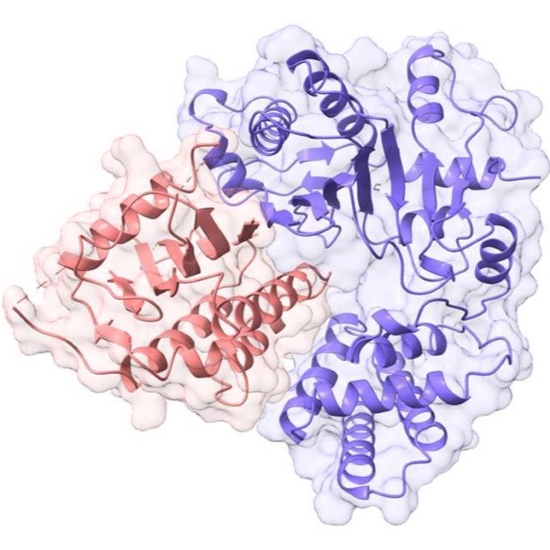Researchers determine shape of nuclear protein that regulates enzymes implicated in cancer, other diseases

A UT Southwestern team of structural biologists determined the shape of a nuclear protein implicated in cancer that acts on a family of enzymes involved in regulating RNA stability. They discovered that although two forms of the BCCIP protein – alpha (α) and beta (β) – are virtually identical, only one of them appears to affect the FAM46 enzymes, and that’s due to a folding mechanism unlike any the researchers had encountered.
“This study reports an unexpected, novel structure of a protein named BCCIP⍺ that appears to underlie its cellular function and role in cancer,” said Xuewu Zhang, Ph.D., Professor of Pharmacology and Biophysics and a corresponding author of the study in Science Advances.
BCCIP⍺ binds FAM46 enzymes, of which there are several including FAM46C, a protein that is considered a tumor-suppressor when functioning normally. Several diseases are associated with malfunctioning FAM46 proteins. Notably, loss-of-function mutations in FAM46C are found in some cases of the blood cancer multiple myeloma, Dr. Zhang explained.
“Determining the structure of a protein is of fundamental importance to understanding how proteins interact, their role in diseases and disorders, drug design, and more,” said Xiaochen Bai, Ph.D., Associate Professor of Biophysics and Cell Biology and the study’s other corresponding author.

This study used cryo-electron microscopy (cryo-EM), in which biological samples are flash frozen and viewed at cryogenic temperatures (minus 321 degrees Fahrenheit) as well as the more traditional X-ray crystallography, in which samples are turned into crystals to solve their structure.
“Our crystal and cryo-EM structures reveal the details of the BCCIP⍺-FAM46 interaction, which we hope will provide a basis for developing targeted drugs for cancer therapy,” Dr. Bai said.
Building on work from the Zhang lab published in 2020 that reported the structure of FAM46C in the current investigation, the team found that BCCIP⍺ adopts a structure that is completely different from any other proteins, including its cousin BCCIPβ, which is virtually the same except for differences in the amino acids at one end, called the C-terminal, said Dr. Zhang.

They found the distinctive C-terminal segment of BCCIPα supports the adoption of the newly identified fold that enables it to form a complex with FAM46 enzymes. The team further found that the interaction of BCCIPα with FAM46C regulates the enzyme’s action by blocking its active site and inhibiting its activity.
“We hope the novel structure of BCCIP⍺, its unique fold, and the way it binds with FAM46C as shown in this work will serve as the basis for future studies on the cellular functions and molecular mechanisms of these disease-relevant proteins, paving the way for developing new therapeutics,” said Dr. Bai.
The study’s three lead authors were Shun Liu, Ph.D., and Yan Yin, Ph.D., both Research Scientists in the Zhang lab; and Hua Chen, Ph.D., formerly of UTSW and now at Janssen Research and Development. Other UTSW co-authors include former postdoctoral researcher Defen Lu, Ph.D., and former graduate student Guoming Gao, Ph.D., both of Pharmacology; and Jie Li, Ph.D., Assistant Instructor of Biophysics.
This work was supported by grants from the National Institutes of Health (R01CA220283 and R01GM143158), The Welch Foundation (I-1702 and I-1944), and the Cancer Prevention and Research Institute of Texas (RP160082). The cryo-EM work was made possible by the cryo-EM facility at UTSW.
Dr. Bai is a Virginia Murchison Linthicum Scholar in Medical Research.
Dr. Zhang is a Virginia Murchison Linthicum Scholar in Medical Research.

